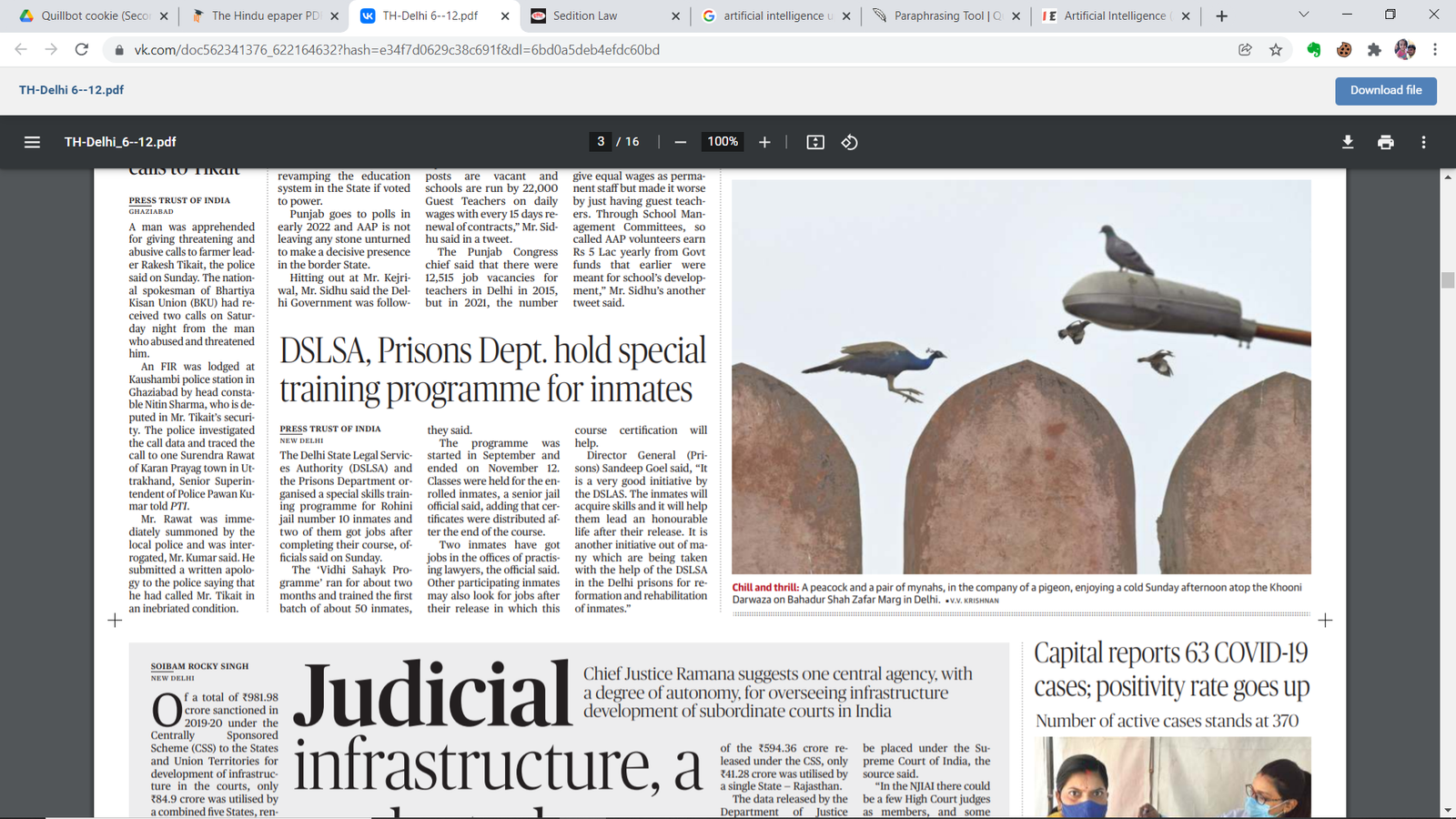
Prepare IAS Coaching
Current Affairs

Title : PRISON REFORMS: Need of the hour
Date : Dec 07, 2021
Description :
Based on a News Article published in the ‘The Hindu’ on 06th December 2021 on Page Number 2, 3
Useful for UPSC CSE Prelims and Mains (GS Paper I & II)
Background:
- The National Crime Records Bureau (NCRB) published Prison Statistics India 2016 in 2019, which shows the plight of Indian prisoners. The data, with its mix of benefits and drawbacks, can help drive India's policy framework toward greater prison reforms.
- Human engineering is supposed to be done in prisons, with the goal of changing people's views, attitudes, and behaviour, but Indian prisons have turned into workshops for crime and atrocities.
- Under Entry 4 of List II of the Seventh Schedule to the Constitution of India, prisons/persons held therein are a State subject. As a result, state governments are responsible for the administration and management of prisons.
The following are some of the report's significant findings:
- In 2016, India's under-trial population remained among the world's highest, with more than half of all undertrials being held for less than six months.
- According to the study, there were 4,33,033 inmates in prison at the end of 2016, with 68 percent of them awaiting trial.
- This shows that the high number of undertrials in the overall jail population may be due to wrongful arrests and inadequate legal representation during remand hearings.
Who exactly are undertrials:
- Undertrials are those who have not yet been found guilty of the offences for which they have been charged.
- In Jammu and Kashmir, the number of persons detained under administrative (or "prevention") detention legislation is increasing.
- With 431 inmates in 2016, compared to 90 in 2015, there was a 300 percent rise.
- Authorities utilise administrative, or 'preventive,' detention to unfairly hold people without charge or trial, circumventing normal criminal justice procedures.
What is Preventive Detention, and how does it work:
- The detention of a person with the purpose of preventing them from committing more crimes or maintaining public order.
- Under Section 436A of the Code of Criminal Procedure, there is a discrepancy between the number of inmates eligible for release and those who are actually released.
- Under Section 436A, undertrials can be freed on a personal bond after serving half of the maximum sentence they would have received if convicted.
- Only 929 of the 1,557 undertrials eligible for parole under Section 436A were freed in 2016.
- Furthermore, according to Amnesty India's study, prison staff are often unaware of this section and hesitant to enforce it.
- Between 2015 and 2016, the number of "abnormal" deaths in jails more than doubled, from 115 to 231.
- Suicide rates among inmates also climbed by 28%, from 77 suicides in 2015 to 102 suicides in 2016.
- According to the National Human Rights Commission, a person is one-and-a-half times more likely to commit suicide in prison than outside. This could be a sign of the seriousness of mental health issues in Indian prisons.
- In 2016, there was only one mental health expert for every 21,650 inmates, with psychologists/psychiatrists available in only six states and one union territory.
- In addition, the NCRB reported that 6,013 people with mental illnesses were in prison in 2016.
- According to the Prison Act of 1894 and the Prisoner Act of 1900, each jail should have a welfare officer and a law officer, but these officials have yet to be hired. This explains why prisons have received such a low political and budgetary priority in the previous century.
Data Set Limitations:
- The data excludes religious demographics as well as the status of convicts in the Scheduled Caste and Scheduled Tribe systems, which are critical to comprehending India's jail population.
- This data has been continuously published for the past 20 years, and it has been critical in highlighting the troubling overrepresentation of Muslims, Dalits, and Adivasis in prisons.
- The number of jail visits by official and non-official visitors, which often include district magistrates and judges, social workers, and researchers, is not included in the data.
- This is critical for exposing torture and other forms of ill-treatment, increasing transparency, and balancing power imbalances in jails.
- The information on the convicts' mental health does not include whether or not they were diagnosed with mental illness prior to their incarceration.
- This makes it difficult to say whether their predicament was made worse by their confinement.
What should the plan for jail reform look like:
- Pre-trial detention has become a specific source of injustice in the Indian court system, owing to a shortage of legal services for those who are being held without charges.
- It is past time for legal aid (which is a directive principle for state policy under Article 39A) to be recognised as a fundamental right.
- Undertrials should be freed on bail: The Indian Law Commission proposed in 2017 that undertrials who have served a third of their maximum sentence for crimes punishable by up to seven years in jail be released on bail.
- Unified prison management system: There should be a unified prison management system that keeps track of all convicts' records so that they don't have to go from pillar to post looking for copies of court orders. NALSA has also given its approval to the proposal. This project has also shown to be successful in the Tihar jail in Delhi.
- Building the capacity of prison staff: It is critical that prison employees be trained in how to treat and deal with convicts.
- In September 2017, the Supreme Court ordered that suitable training manuals for senior officials be created.
- Prisoners' post-release financial security: Wages paid to convicts serving sentences should be enhanced and brought up to level with international standards. So that when they're ready to come out, they'll be in a better financial position.
- Development of inmates' skills: The main purpose of prisons should be to reform inmates and ensure that they are effectively incorporated into society after they are released. This is conceivable if more skill development programmes are implemented in jails to increase inmates' possibilities of earning money.
- Prisons that are open to the public should be encouraged.
- The recommendations of the All India Jail Reforms Committee (Mulla Committee) must be implemented as quickly as practicable.
Next Steps:
- The data can serve as a solid foundation for the country's prison reform agenda.
- Policymakers should examine its flaws in order to create a strong, humane, and transparent reform mechanism.
- Both the problem of a lack of resources and the mindset that those in prison do not deserve better should be addressed by the reform agenda.
- Overcrowding, cruelty, a lack of sanitation, and unacceptably low health-care standards should all be taken into account.
- The increasingly harsh nature of public discourse on the treatment of offenders should be recognised, and debate should be re-opened with human rights issues in mind.
- India is a global champion of human rights issues, but the poor state of Indian prisons underscores the contradictions in the Indian criminal justice system.
- As a result, prison changes must be implemented, but they must be accompanied by judicial and police reforms, as the three pillars of the criminal justice system.
